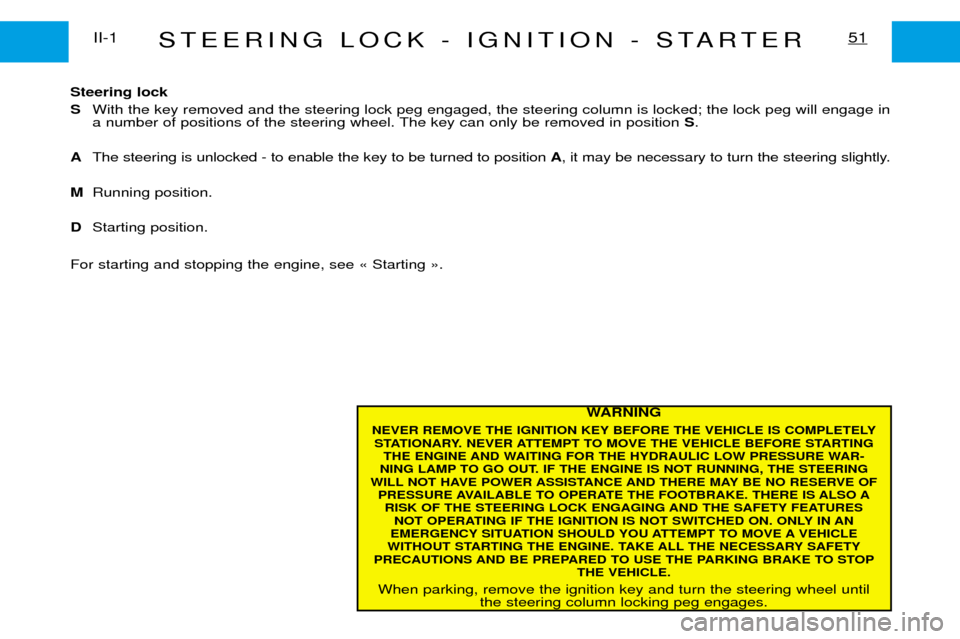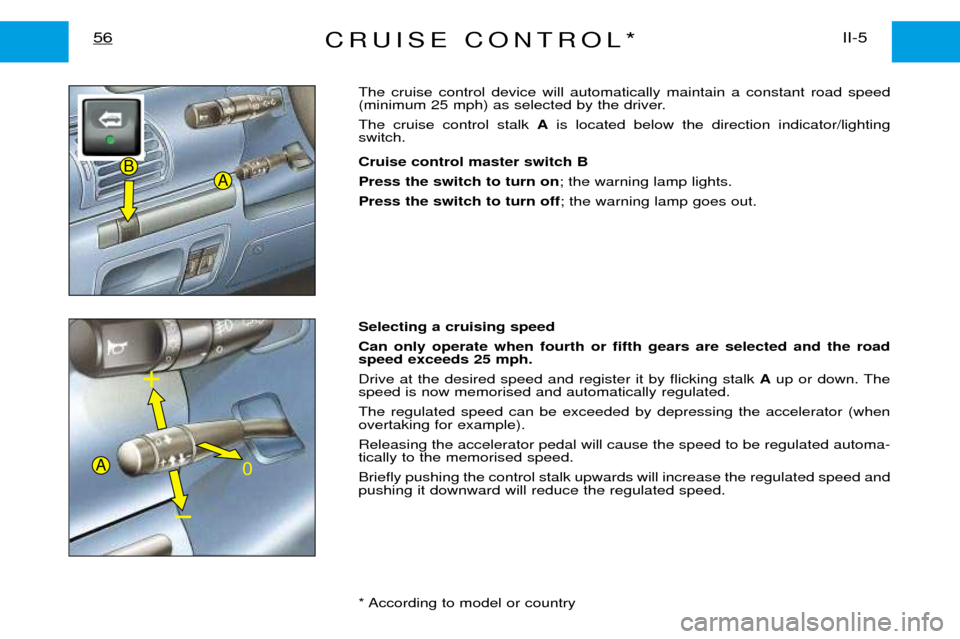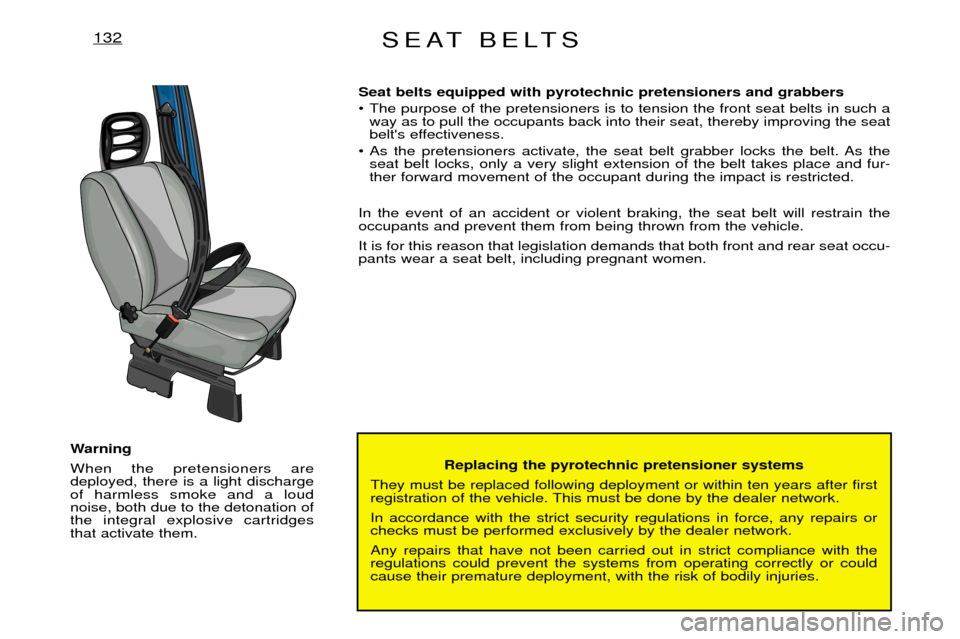Page 64 of 149
STEERING LOCK - IGNITION - STARTERII-1
50
¥ S : Steering lock
To free the steering, turn the steering wheel slightly at the same time as tur- ning the key; avoid using undue force.
¥ A : Accessories
Allows certain electrical accessories to be used. The battery charge warning lamp illuminates.
¥ M : Ignition The following warning lamps should come on: battery charge, handbrake, oil
pressure, engine coolant temperature According to the specific version of
vehicle, the following warning lamps should also come on: Stop, ABS, Engineautodiagnostic, Preheating (Diesel), Front airbag. If one of these lamps fails to light, it could indicate a fault in the system concerned. ¥ D : Starter Release the key as soon as the engine has started. Never operate with the engine running.
These warning lamps are tested with the ignition key in the ignition on position.
Page 65 of 149

STEERING LOCK - IGNITION - STARTER51II-1
WARNING
NEVER REMOVE THE IGNITION KEY BEFORE THE VEHICLE IS COMPLETELY STATIONARY. NEVER ATTEMPT TO MOVE THE VEHICLE BEFORE STARTING THE ENGINE AND WAITING FOR THE HYDRAULIC LOW PRESSURE WAR-
NING LAMP TO GO OUT. IF THE ENGINE IS NOT RUNNING, THE STEERING
WILL NOT HAVE POWER ASSISTANCE AND THERE MAY BE NO RESERVE OF PRESSURE AVAILABLE TO OPERATE THE FOOTBRAKE. THERE IS ALSO ARISK OF THE STEERING LOCK ENGAGING AND THE SAFETY FEATURES NOT OPERATING IF THE IGNITION IS NOT SWITCHED ON. ONLY IN AN
EMERGENCY SITUATION SHOULD YOU ATTEMPT TO MOVE A VEHICLE
WITHOUT STARTING THE ENGINE. TAKE ALL THE NECESSARY SAFETY
PRECAUTIONS AND BE PREPARED TO USE THE PARKING BRAKE TO STOP THE VEHICLE.
When parking, remove the ignition key and turn the steering wheel until the steering column locking peg engages.
Steering lock
S With the key removed and the steering lock peg engaged, the steering column is locked; the lock peg will engage in
a number of positions of the steering wheel. The key can only be removed in position S.
A The steering is unlocked - to enable the key to be turned to position A, it may be necessary to turn the steering slightly.
M Running position.
D Starting position.
For starting and stopping the engine, see Ç Starting È.
Page 68 of 149
BRAKESII-3
54
Handbrake
To create a passage between the front seats, the handbrake lever is mounted
to the left of the driverÕs seat. The handbrake is operated by pulling the lever firmly up - pressing the foot-
brake will reduce the effort required to apply the handbrake. The handbrake is capable of holding the vehicle on all slopes likely to be
encountered but increased effort will be needed on steep slopes.
In all circumstances, as a precautionary measure, engage first gear.On steep slopes, turn the steering towards the kerb.
To release the brake, pull the lever lightly up, press the button on the end of the lever and return the lever to the fully down position. The warning lamp will come on if the handbrake is on or not fully released when the engine is running .
Page 70 of 149

CRUISE CONTROL*II-5
56
The cruise control device will automatically maintain a constant road speed
(minimum 25 mph) as selected by the driver. The cruise control stalk Ais located below the direction indicator/lighting
switch. Cruise control master switch B Press the switch to turn on ; the warning lamp lights.
Press the switch to turn off ; the warning lamp goes out.
Selecting a cruising speedCan only operate when fourth or fifth gears are selected and the road speed exceeds 25 mph. Drive at the desired speed and register it by flicking stalk Aup or down. The
speed is now memorised and automatically regulated.The regulated speed can be exceeded by depressing the accelerator (when overtaking for example). Releasing the accelerator pedal will cause the speed to be regulated automa- tically to the memorised speed. Briefly pushing the control stalk upwards will increase the regulated speed and pushing it downward will reduce the regulated speed.
* According to model or country
0A
AB
Page 79 of 149

SEAT BELTS132
Replacing the pyrotechnic pretensioner systems
They must be replaced following deployment or within ten years after first
registration of the vehicle. This must be done by the dealer network. In accordance with the strict security regulations in force, any repairs or checks must be performed exclusively by the dealer network. Any repairs that have not been carried out in strict compliance with the regulations could prevent the systems from operating correctly or couldcause their premature deployment, with the risk of bodily injuries.
Warning When the pretensioners are deployed, there is a light dischargeof harmless smoke and a loudnoise, both due to the detonation ofthe integral explosive cartridgesthat activate them. Seat belts equipped with pyrotechnic pretensioners and grabbers
¥ The purpose of the pretensioners is to tension the front seat belts in such a
way as to pull the occupants back into their seat, thereby improving the seat
belt's effectiveness.
¥ As the pretensioners activate, the seat belt grabber locks the belt. As the seat belt locks, only a very slight extension of the belt takes place and fur-ther forward movement of the occupant during the impact is restricted.
In the event of an accident or violent braking, the seat belt will restrain theoccupants and prevent them from being thrown from the vehicle. It is for this reason that legislation demands that both front and rear seat occu- pants wear a seat belt, including pregnant women.
Page 83 of 149

AIR CONDITIONING*III-2
68
Air conditioning
The air conditioning system will only operate with the engine running. Press the switch Aon the dashboard.
A warning lamp confirms that the system is switched on.
For the air conditioning to be fully effective, the windows should be closed. The system contains a non-polluting CFC sub- stitute. If after a prolonged stop in direct sunlight the inside of the car is hot, leave the windows openfor a few minutes to provide a rapid air change,then close them.
Air recycling
To obtain the most effective cooling in the pas-senger compartment in very hot conditions,select the recycling position. Set control Bto the left, and place the heater
blower control Din the mid-way position.
It is recommended that the control not be left in the recycling position for longer than necessa-
ry. The normal position will provide a conti-nuous fresh air supply to the passenger com-partment. Rapid demisting Switch on the air conditioning.Set the control to the fresh air position and air flow to
maximum.Select the demisting position using control C.
Set the temperature control to maximum. Note: A normal consequence of having the air conditioning turned
on is that water condenses on the surface of the air conditioner. This drains out through a specially provided hole and may form apuddle under the car when parked.
To maintain effective operation of the compressor seals, ope- rate the air conditioning at least once a month. The air conditioning is useful even in winteras it can be used to
remove moisture from the air.ABC
D
* According to model or country
Protection fuses (under the dashboard)F5 - F20 - F25
(under the bonnet)
F13 - F15 (with ABS)
Page 111 of 149
TABLE OF FUSES
(According to model or country)V- 2
90
Fuses under the dashboard
Number Rating Functions
F1 10 A Audio system (supply)
F2 5 A Ignition + position - Speed sensor - PCPU - Instrument panel warning lamps
F3 15 A Stop lamp - Cruise control
F4 10 A Rear RH tailgate lamp - Front LH sidelamp - Headlamp adjustment
F5 10 A Air conditioning - Electric front windows - Air blower - Pressostat
F6 15 A Heated rear window & heated seats
F7 20 A Horn
F8 SHUNT Ñ
F9 5 A Headlamp washer - Front RH sidelamp - Number plate lighting - Rear LH lamp
F10 30 A Unused
F11 30 A Unused
F12 10 A ABS control unit Ð Reversing lamps Ð Diagnostic socket Ð Auto gearbox
F13 30 A Unused
F14 5 A PCPU
Page 112 of 149
TABLE OF FUSES
(According to model or country)91V- 2
Number Rating Functions
F15 30 A PCPU (central locking Ð ceiling lights)
F16 20 A Cigar lighter - Permanent + position
F16A 20 A Cigar lighter - Accessories + position
F17 15 A Coolant temperature control unit - Cooling fan assembly
F18 10 A Foglamp
F19 10 A Instrument panel lighting - Audio system - Sidelamps
F20 30 A Air conditioning - Air blower
F21 20 A Heated seats
F22 20 A Accessories + position - Unused
F23 SHUNT F14 - F15 - F25 - F27
F24 30 A Windscreen washer - Windscreen wiper
F25 10 A Air conditioning - Interior lamp - Radio memory - Digital clock
F26 15 A Hazard warning lamps
F27 30 A Heated rear screen
F28 15 A Electric window - Charge warning lamp
F29 30 A Electric window
F30 15 A Interior lighting - Direction indicators - Clock - Electric rear view mirror